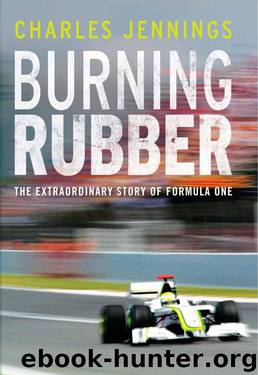Burning Rubber: The Extraordinary Story of Formula One by Jennings Charles

Author:Jennings, Charles [Jennings, Charles]
Language: eng
Format: epub, mobi
Publisher: Quercus
Published: 2010-02-03T22:00:00+00:00
There’s something anomalous about all this, when you consider how much Ford, Firestone, Goodyear, Texaco, Esso, Mobil, Champion Spark Plugs, to name just the big ones, have contributed to Formula One over the years. So many millions of US dollars have flooded into the sport, and yet you can count the number of major American drivers on the fingers of one hand. Fair enough, the industry had no choice but to put money into Formula One, given its reach as a marketing tool throughout Europe and the rest of the non-US world. But why has the sport habitually meant so little, back in the States? Why has it gained so small a cultural purchase?
And why, for that matter, have the Americans had such a hard time of it, trying to find somewhere suitable to stage a Grand Prix?
The first couple of attempts, in the late 1950s, were at the Sebring track in Florida, and Riverside, California, with neither event generating a sufficiently big take at the gate to ensure a rerun. So the event moved on to Watkins Glen, which held its first United States Grand Prix in 1961, and which, as locus of the United States GP, was for a long while voted best-staged Grand Prix of the season (by the GPDA), very possibly in grateful recognition of the vast amount of prize money the Americans put on offer.
After all, in the mid-1960s, in Europe, it was starting money that kept many teams going – around £25,000 a race, split between perhaps ten outfits. That was the pot. And then they arrived at Watkins Glen, where, in 1966, instead of starting money, there was a single gargantuan bucket of prize money – over $100,000 in total, with $20,000 going to the race winner, all the way down to nearly $3,000 for whoever ended up in twentieth place. It seemed as if you couldn’t lose. In fact, the $20,000 cash prize for race winner was more than all the first-place prize money of all the other Grands Prix put together. ‘$100,000 was a magic number at the time,’ confessed Cameron Argetsinger, the race organiser, putting his finger right on it.
It should have been perfect, but it wasn’t. The happy relationship didn’t last. The 1960s were great, the early 1970s were okay, but by the end of the 1970s, the Glen had begun to turn from a fun-filled cash-cow into a slightly tawdry, behind-the-times hangover. There was a chronic lack of desire, somewhere in the system. The track wasn’t kept up to date, with the result that it was too lumpy for the new generation of ground-effect cars. The facilities for the teams and the press corps were increasingly cramped and tatty. There was (amazingly, for the States) a shortage of suitable nearby hotel accommodation. And there was, apparently, ‘hooliganism’ among the well-beered-up young guns who liked to frequent motor races.
This last sounds unlikely, but it was true. Down in the infield of the Glen lay an area of badly drained land which, after rainfall, turned into a bog.
Download
Burning Rubber: The Extraordinary Story of Formula One by Jennings Charles.mobi
This site does not store any files on its server. We only index and link to content provided by other sites. Please contact the content providers to delete copyright contents if any and email us, we'll remove relevant links or contents immediately.
The Inner Game of Tennis by W. Timothy Gallwey(3481)
Unstoppable by Maria Sharapova(3409)
Urban Outlaw by Magnus Walker(3250)
Crazy Is My Superpower by A.J. Mendez Brooks(3210)
Mind Fuck by Manna Francis(3041)
The Social Psychology of Inequality by Unknown(2774)
The Fight by Norman Mailer(2710)
Unstoppable: My Life So Far by Maria Sharapova(2388)
Accepted by Pat Patterson(2221)
Going Long by Editors of Runner's World(2217)
Futebol by Alex Bellos(2138)
The Happy Runner by David Roche(2128)
Motorcycle Man by Kristen Ashley(2118)
Backpacker the Complete Guide to Backpacking by Backpacker Magazine(2112)
The Sports Gene: Inside the Science of Extraordinary Athletic Performance by David Epstein(2064)
Sea Survival Handbook by Keith Colwell(2045)
Peak: Secrets from the New Science of Expertise by Anders Ericsson & Robert Pool(1928)
Endure by Alex Hutchinson(1874)
The Call of Everest by Conrad Anker(1789)
